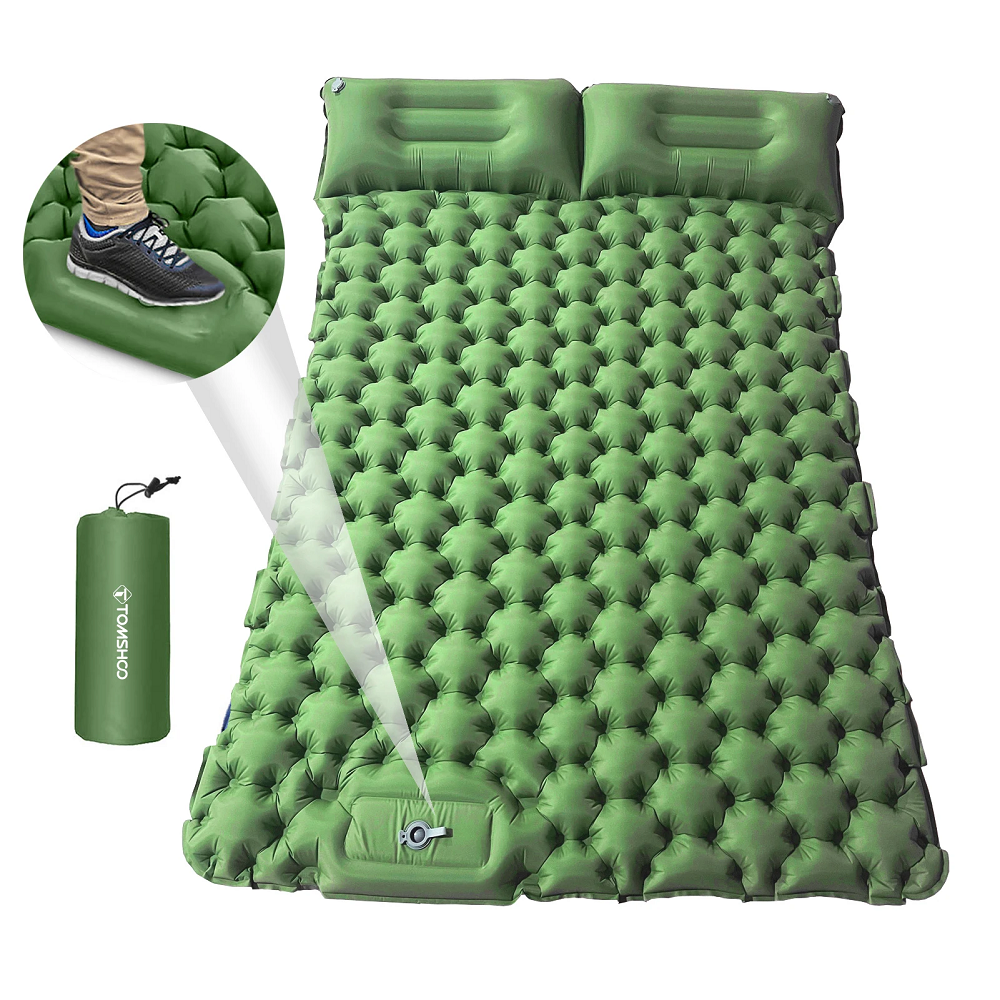Importance of Comfort During Camping
Camping is an amazing way to connect with nature. However, enjoying the experience fully depends on your comfort. One key factor is having a good night’s rest. Choosing the right camping air mattress can make a big difference.
Why a Good Sleep Matters in the Outdoors
Sleep is essential for energy and mood. When camping, tiring activities like hiking and exploring demand proper rest. A good camping air mattress supports your body and prevents aches. Poor sleep could ruin your outdoor adventure, leaving you feeling exhausted.
Camping brings unique sleep challenges, like uneven ground and chilly weather. A high-quality mattress helps overcome these barriers. It provides a soft, reliable surface to recharge after a long day.
Common Challenges of Sleeping in Nature
Sleeping outdoors may seem exciting, but several challenges arise. Uneven ground can create pressure points and discomfort. Rocks and roots beneath a tent floor can interrupt sleep. A camping air mattress evens out surfaces, improving comfort.
Another common issue is temperature regulation. Nights can get cold, even in summer. A mattress with insulation can keep you warm. Noise is another factor; rustling leaves or wildlife sounds might disturb you. Being well-rested helps you tackle these issues better.
Lastly, weight and portability matter. Carrying bulky equipment is tiring. Lightweight camping air mattresses are ideal for easy transport. These mattresses combine portability with comfort, enhancing your camping experience.
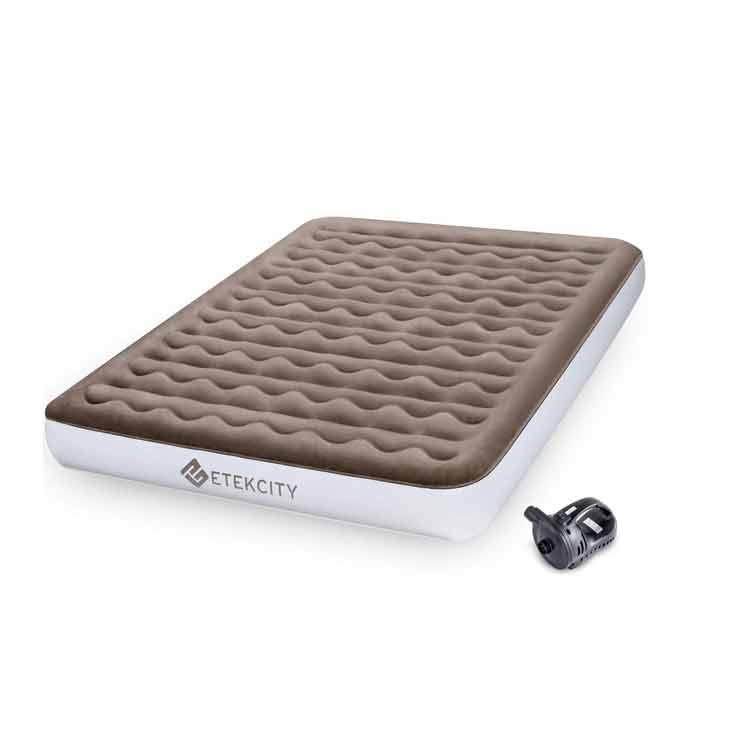
Types of Camping Air Mattresses
Choosing the right type of camping air mattress is crucial for comfort and convenience. Different types cater to varying preferences and camping needs. Here are three popular options to consider:
Self-Inflating Air Mattresses
Self-inflating air mattresses are among the most convenient options. These mattresses require minimal effort to set up. They typically feature a combination of foam and airtight fabric. You just open the valve, and the mattress inflates itself.
Advantages include easy portability and good insulation. The built-in foam provides extra cushioning, making them more comfortable. They are ideal for campers who want quick setup and reduced hassle. However, they may be bulkier compared to other types.
Manual Inflatable Air Mattresses
Manual inflatable air mattresses offer flexibility and lightweight design. These mattresses use air pumps or mouth inflation. This lets campers control the firmness level.
Their main advantage is portability; they are compact and easy to carry. Manual mattresses are often made from durable materials like PVC or TPU. They are perfect for hikers and those traveling long distances. The drawback is the effort required for inflation, which can be tiresome for some.
Foam Core Options
Foam core camping mattresses are solid, not inflatable. These mattresses use dense foam to create a cushioned sleeping surface. They do not require air, making them more reliable and puncture-resistant.
These mattresses are great for cold-weather camping due to their insulation properties. They are durable and offer consistent comfort. However, they tend to be heavier and less portable than inflatable types. Foam mattresses work well for car camping or short trips when weight isn’t an issue.

Key Features to Look for
Choosing the perfect camping air mattress requires an understanding of its key features. These features influence the overall comfort and usability. The right choice ensures a restful sleep in outdoor environments.
Durability and Material Quality
Durability is crucial for a camping air mattress. Outdoor terrains can be harsh, with sharp rocks and roots potentially causing damage. Look for mattresses made from tough materials like PVC, TPU, or ripstop nylon. These materials resist punctures and wear. Quality stitching also enhances durability, preventing air leaks over time. A sturdy mattress lasts longer and performs reliably during trips.
Size and Weight Considerations
Size and weight are important for portability. Choose a mattress that fits your tent and sleeping needs. For solo camping, smaller sizes work well, while group trips may need larger options. Lightweight models are great for hikers, reducing the load you carry. However, balance portability with thickness and comfort. Find a size and weight that works for your camping style.
Inflation and Deflation Mechanisms
Efficient inflation and deflation mechanisms save time and effort. Self-inflating mattresses are quick and hassle-free. Manual mattresses require hand pumps or mouth inflation but offer control over firmness. Always check for reliable valves and seals to prevent air leaks. Easy setup and packing ensure convenience during your trip.
Temperature Regulation and Insulation
Camping air mattresses must handle outdoor temperature changes. Insulated mattresses retain warmth, offering comfort in chilly weather. Foam-core mattresses especially provide great insulation. For summer trips, non-insulated mattresses prevent overheating. Good temperature regulation ensures restful sleep in any season.
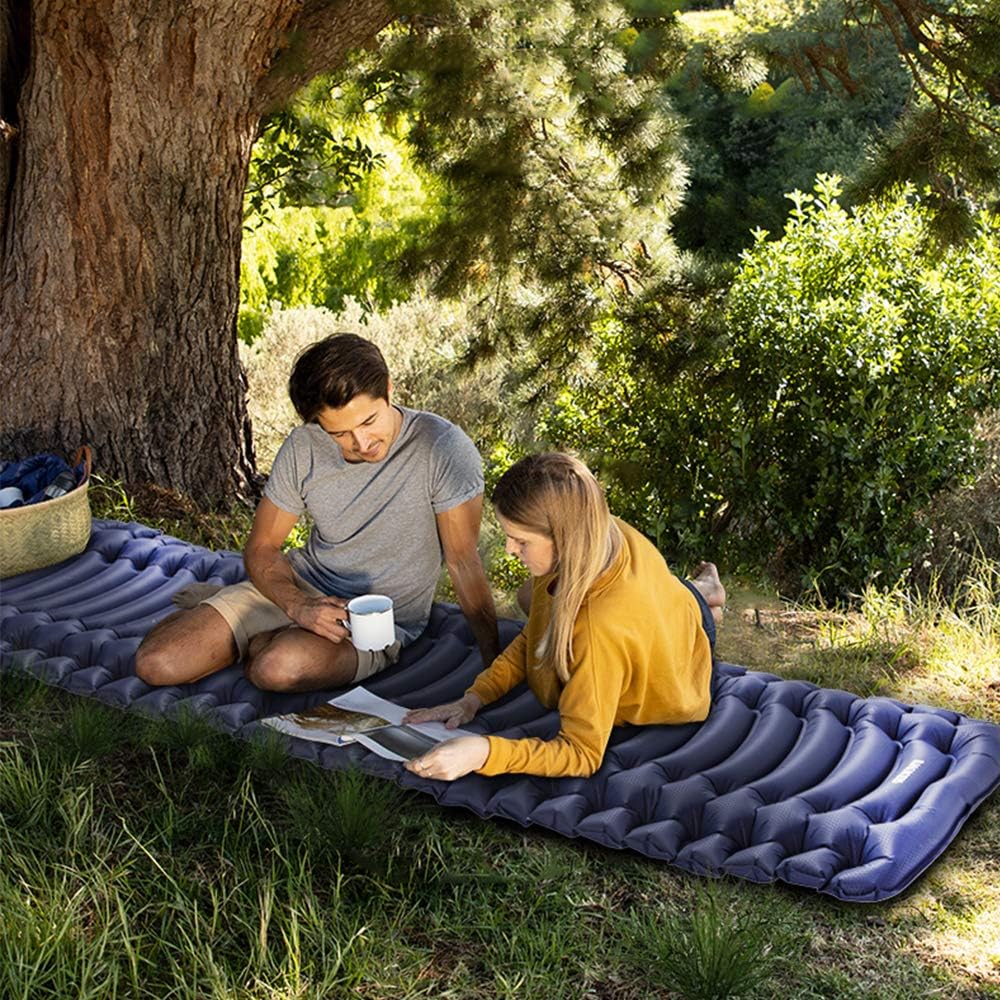
Comparing Popular Brands and Models
Choosing a camping air mattress can be overwhelming. Popular brands offer a wide range of models, catering to various preferences and budgets. It’s essential to compare features, durability, and comfort to make the best choice.
Top-Rated Camping Air Mattresses
Top-rated camping air mattresses focus on quality and performance. Brands like Therm-a-Rest and Exped produce reliable, durable options. Models such as Therm-a-Rest’s NeoAir Xlite are lightweight and portable. These sleeping pads provide excellent insulation and are ideal for backpackers. Exped’s MegaMat is known for its luxurious comfort and thick foam filling. Though pricier, they promise long-lasting quality for regular campers.
Other notable brands include Coleman and Intex. Coleman air mattresses are durable and affordable, great for casual campers. Intex mattresses focus on compactness and ease of use. These popular models ensure better sleep in rugged outdoor conditions.
Budget-Friendly Options
Budget-friendly camping air mattresses prioritize affordability without compromising basic comfort. Brands like EnerPlex and SoundAsleep offer inexpensive options for beginners. EnerPlex models are lightweight and easy to transport. They include features such as manual inflation for added control. SoundAsleep mattresses use durable PVC materials, ensuring good resistance to punctures.
Coleman’s QuickBed is another affordable choice, featuring soft flocking for extra comfort. These mattresses provide decent insulation and portability for short camping trips. Budget options are perfect for campers on a tight budget or occasional adventurers.
High-End Models for Maximum Comfort
High-end camping air mattresses emphasize luxury and premium materials. If you want maximum comfort, look at brands like Sea-to-Summit and Exped. Sea-to-Summit mattresses, like their Comfort Plus series, offer dual-layer inflation for precise control. They feature advanced fabrics to ensure durability and excellent temperature regulation.
Exped’s DeepSleep line balances thick foam layers with portability for car camping. For extreme durability, check offerings from Big Agnes. Their Insulated Q-Core SLX is ultralight yet incredibly comfortable. High-end models require larger investments but often include advanced insulation, reliable valves, and superior construction.
Choosing between brands and models depends on your camping style, budget, and sleep preferences. Compare features carefully to find the perfect camping air mattress for your next outdoor adventure.
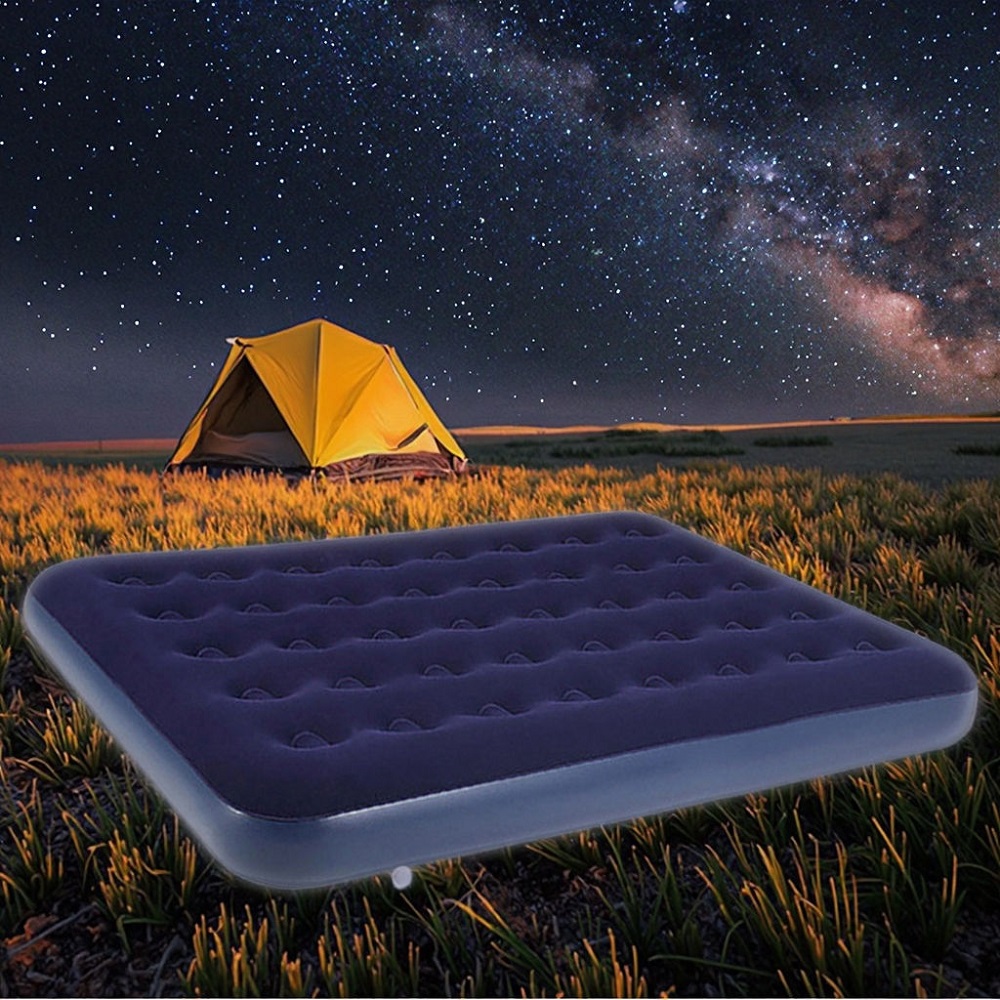
Maintaining and Caring for Your Air Mattress
Proper care ensures your camping air mattress lasts longer. Regular maintenance prevents damage and keeps it functional. With good care, your mattress will remain comfortable and reliable for many camping trips.
Proper Storage and Cleaning Tips
Store your camping air mattress in a dry and cool place. Avoid direct sunlight or extreme heat. Fold it carefully to prevent creases and wear over time. Use the storage bag, if provided, to protect it from dust.
Clean the mattress after every trip. Use a damp cloth and mild soap to clean dirt and stains. Avoid harsh chemicals that could damage the material. Let the mattress dry completely before storing to prevent mold or mildew.
Inspect your mattress regularly for wear or holes. Check seams and valves to ensure they function properly. Proper storage and cleaning extend its usability and enhance your camping experiences.
Repairing Punctures and Wear
Repair punctures immediately to prevent further damage. Identify the hole first by inflating the mattress and listening for air leaks. Use a patch kit designed for air mattresses to seal holes effectively.
Follow the instructions in the kit carefully. Clean the area around the puncture before applying the patch. Press firmly to ensure a tight seal. Test the repair by inflating the mattress to check for leaks.
If seams or valves are damaged, consult the manufacturer for replacement parts. Routine checks and timely repairs ensure your mattress stays dependable for outdoor adventures. Always keep a patch kit in your camping gear for emergencies.
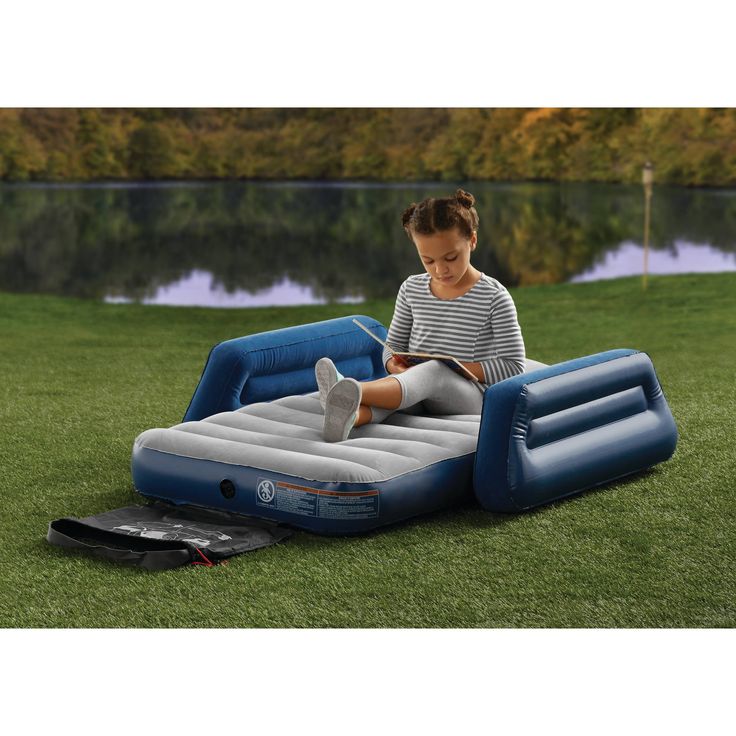
Tips for Choosing the Best Mattress for Your Needs
Choosing the best camping air mattress involves understanding your environment and personal comfort preferences. These factors ensure a restful and enjoyable outdoor experience.
Considering Your Camping Environment
Your camping location affects the type of air mattress you need. Evaluate the terrain first. Uneven ground requires thicker mattresses for better support and comfort. For smooth surfaces, any option may suffice.
Weather plays a crucial role too. Cold environments need insulated mattresses to retain heat. Foam core options work well in such cases. In warm climates, seek breathable or non-insulated mattresses to prevent overheating.
Also, consider the weight of your gear. Backpackers should prioritize lightweight and compact mattresses. Car campers can opt for heavier, more comfortable options. Matching your mattress to the environment guarantees better sleep and usability.
Matching Mattress Features to Personal Preferences
Your comfort preferences should guide your choice. First, assess the mattress’s firmness. Manual inflatable mattresses let you adjust firmness for personalized support. Foam core mattresses offer consistent cushioning but lack customization.
Next, think about ease of use. Self-inflating mattresses simplify setup and save time. Manual options provide control but require extra effort. Choose based on your patience and convenience needs.
Durability is equally vital. If you camp often, invest in high-quality materials like TPU or PVC. Occasional campers might prefer budget-friendly models. Ensure your chosen mattress matches your sleeping style and long-term use plans.
By considering environment and preferences, it’s easy to find the perfect camping air mattress for your adventures.
Frequently Asked Questions About Camping Air Mattresses
How to Avoid Leaks and Punctures
Preventing leaks starts with careful handling. Avoid placing your mattress near sharp objects or rough surfaces. Use a groundsheet to protect it from roots, rocks, and debris. Inspect the area before setting up your tent and mattress.
Choose a camping air mattress made from durable materials like TPU or PVC. These materials resist punctures and wear. Always follow the manufacturer’s guidelines for setup and usage to improve its lifespan.
Carry a repair kit for emergencies. If a puncture occurs, repair it immediately to prevent further damage. Proper care and timely action reduce the risk of leaks.
Best Practices for Storing an Air Mattress
Store your air mattress in a clean, dry spot when not in use. Avoid exposing it to direct sunlight or extreme heat, as these can weaken materials like PVC or TPU. Use the original storage bag, if available, for added protection from dust and moisture.
Clean your mattress after each trip to remove dirt or stains. Use mild soap and a damp cloth, then let it dry completely. Ensure no moisture remains to prevent mold or odor formation.
Fold or roll the mattress gently to avoid damaging seams or valves. Regular inspections before storing help detect wear, ensuring the mattress stays in good condition.
How Long Do Camping Air Mattresses Last?
Camping air mattresses can last several years if cared for properly. Durability depends on material quality, usage frequency, and maintenance practices.
High-quality mattresses made from TPU or PVC often perform longer than budget-friendly options. Regular cleaning, correct storage, and careful handling extend their lifespan significantly.
Frequent camping may wear out the mattress faster. Occasional users often experience extended durability. Replace valves, patches, or seams as needed to maintain functionality. Proper habits ensure reliable performance during your outdoor adventures.
Finding the Right Camping Air Mattress
In conclusion, selecting the perfect camping air mattress is vital for ensuring comfort during your outdoor adventures. The right decision can lead to restful nights and enjoyable days full of activities. Consider your personal sleeping preferences, the type of camping you’ll be doing, and the features that matter most to you.
From the thickness and material to the inflation method and size options, there are numerous factors to evaluate. Taking the time to identify what works best for your needs will enhance your camping experience. Proper care and maintenance can extend the life of your mattress and ensure it is always ready for your next adventure.
Investing in a high-quality camping air mattress will pay off in comfort and overall satisfaction during your camping trips. So gear up, find the right mattress, and prepare to embrace the great outdoors with confidence and relaxation! Happy camping!
